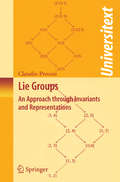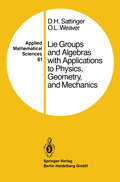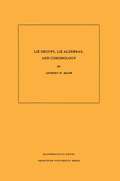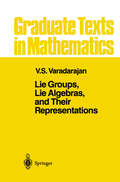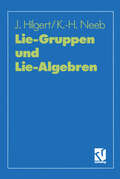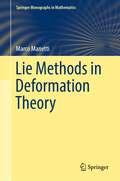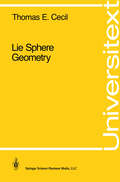- Table View
- List View
Lie Groups: In Honor of Joseph A. Wolf on the Occasion of his 75th Birthday (Progress in Mathematics #306)
by Alan Huckleberry, Ivan Penkov and Gregg ZuckermanLie Groups: Structures, Actions, and Representations, In Honor of Joseph A. Wolf on the Occasion of his 75th Birthday consists of invited expository and research articles on new developments arising from Wolf's profound contributions to mathematics. Due to Professor Wolf’s broad interests, outstanding mathematicians and scholars in a wide spectrum of mathematical fields contributed to the volume. Algebraic, geometric, and analytic methods are employed. More precisely, finite groups and classical finite dimensional, as well as infinite-dimensional Lie groups, and algebras play a role. Actions on classical symmetric spaces, and on abstract homogeneous and representation spaces are discussed. Contributions in the area of representation theory involve numerous viewpoints, including that of algebraic groups and various analytic aspects of harmonic analysis. Contributors D. Akhiezer T. OshimaA. Andrada I. PacharoniM. L. Barberis F. RicciL. Barchini S. RosenbergI. Dotti N. ShimenoM. Eastwood J. TiraoV. Fischer S. TreneerT. Kobayashi C.T.C. WallA. Korányi D. WallaceB. Kostant K. WiboontonP. Kostelec F. XuK.-H. Neeb O. YakimovaG. Olafsson R. ZierauB. Ørsted
Lie Groups (Graduate Texts in Mathematics #225)
by Daniel BumpThis book is intended for a one-year graduate course on Lie groups and Lie algebras. The book goes beyond the representation theory of compact Lie groups, which is the basis of many texts, and provides a carefully chosen range of material to give the student the bigger picture. The book is organized to allow different paths through the material depending on one's interests. This second edition has substantial new material, including improved discussions of underlying principles, streamlining of some proofs, and many results and topics that were not in the first edition.For compact Lie groups, the book covers the Peter–Weyl theorem, Lie algebra, conjugacy of maximal tori, the Weyl group, roots and weights, Weyl character formula, the fundamental group and more. The book continues with the study of complex analytic groups and general noncompact Lie groups, covering the Bruhat decomposition, Coxeter groups, flag varieties, symmetric spaces, Satake diagrams, embeddings of Lie groups and spin. Other topics that are treated are symmetric function theory, the representation theory of the symmetric group, Frobenius–Schur duality and GL(n) × GL(m) duality with many applications including some in random matrix theory, branching rules, Toeplitz determinants, combinatorics of tableaux, Gelfand pairs, Hecke algebras, the "philosophy of cusp forms" and the cohomology of Grassmannians. An appendix introduces the reader to the use of Sage mathematical software for Lie group computations.
Lie Groups (Graduate Texts in Mathematics #225)
by Daniel BumpThis book proceeds beyond the representation theory of compact Lie groups (which is the basis of many texts) and offers a carefully chosen range of material designed to give readers the bigger picture. It explores compact Lie groups through a number of proofs and culminates in a "topics" section that takes the Frobenius-Schur duality between the representation theory of the symmetric group and the unitary groups as unifying them.
Lie Groups (Universitext)
by J.J. Duistermaat Johan A.C. KolkThis (post) graduate text gives a broad introduction to Lie groups and algebras with an emphasis on differential geometrical methods. It analyzes the structure of compact Lie groups in terms of the action of the group on itself by conjugation, culminating in the classification of the representations of compact Lie groups and their realization as sections of holomorphic line bundles over flag manifolds. Appendices provide background reviews.
Lie Groups: An Approach through Invariants and Representations (Universitext)
by Claudio ProcesiLie groups has been an increasing area of focus and rich research since the middle of the 20th century. In Lie Groups: An Approach through Invariants and Representations, the author's masterful approach gives the reader a comprehensive treatment of the classical Lie groups along with an extensive introduction to a wide range of topics associated with Lie groups: symmetric functions, theory of algebraic forms, Lie algebras, tensor algebra and symmetry, semisimple Lie algebras, algebraic groups, group representations, invariants, Hilbert theory, and binary forms with fields ranging from pure algebra to functional analysis. By covering sufficient background material, the book is made accessible to a reader with a relatively modest mathematical background. Historical information, examples, exercises are all woven into the text. This unique exposition is suitable for a broad audience, including advanced undergraduates, graduates, mathematicians in a variety of areas from pure algebra to functional analysis and mathematical physics.
Lie Groups (Latin American Mathematics Series)
by Luiz A. San MartinThis textbook provides an essential introduction to Lie groups, presenting the theory from its fundamental principles. Lie groups are a special class of groups that are studied using differential and integral calculus methods. As a mathematical structure, a Lie group combines the algebraic group structure and the differentiable variety structure. Studies of such groups began around 1870 as groups of symmetries of differential equations and the various geometries that had emerged. Since that time, there have been major advances in Lie theory, with ramifications for diverse areas of mathematics and its applications.Each chapter of the book begins with a general, straightforward introduction to the concepts covered; then the formal definitions are presented; and end-of-chapter exercises help to check and reinforce comprehension. Graduate and advanced undergraduate students alike will find in this book a solid yet approachable guide that will help them continue their studies with confidence.
Lie Groups and Algebraic Groups (Springer Series in Soviet Mathematics)
by Arkadij L. Onishchik Ernest B. VinbergThis book is based on the notes of the authors' seminar on algebraic and Lie groups held at the Department of Mechanics and Mathematics of Moscow University in 1967/68. Our guiding idea was to present in the most economic way the theory of semisimple Lie groups on the basis of the theory of algebraic groups. Our main sources were A. Borel's paper [34], C. ChevalIey's seminar [14], seminar "Sophus Lie" [15] and monographs by C. Chevalley [4], N. Jacobson [9] and J-P. Serre [16, 17]. In preparing this book we have completely rearranged these notes and added two new chapters: "Lie groups" and "Real semisimple Lie groups". Several traditional topics of Lie algebra theory, however, are left entirely disregarded, e.g. universal enveloping algebras, characters of linear representations and (co)homology of Lie algebras. A distinctive feature of this book is that almost all the material is presented as a sequence of problems, as it had been in the first draft of the seminar's notes. We believe that solving these problems may help the reader to feel the seminar's atmosphere and master the theory. Nevertheless, all the non-trivial ideas, and sometimes solutions, are contained in hints given at the end of each section. The proofs of certain theorems, which we consider more difficult, are given directly in the main text. The book also contains exercises, the majority of which are an essential complement to the main contents.
Lie Groups and Algebras with Applications to Physics, Geometry, and Mechanics (Applied Mathematical Sciences #61)
by D.H. Sattinger O.L. WeaverThis book is intended as an introductory text on the subject of Lie groups and algebras and their role in various fields of mathematics and physics. It is written by and for researchers who are primarily analysts or physicists, not algebraists or geometers. Not that we have eschewed the algebraic and geo metric developments. But we wanted to present them in a concrete way and to show how the subject interacted with physics, geometry, and mechanics. These interactions are, of course, manifold; we have discussed many of them here-in particular, Riemannian geometry, elementary particle physics, sym metries of differential equations, completely integrable Hamiltonian systems, and spontaneous symmetry breaking. Much ofthe material we have treated is standard and widely available; but we have tried to steer a course between the descriptive approach such as found in Gilmore and Wybourne, and the abstract mathematical approach of Helgason or Jacobson. Gilmore and Wybourne address themselves to the physics community whereas Helgason and Jacobson address themselves to the mathematical community. This book is an attempt to synthesize the two points of view and address both audiences simultaneously. We wanted to present the subject in a way which is at once intuitive, geometric, applications oriented, mathematically rigorous, and accessible to students and researchers without an extensive background in physics, algebra, or geometry.
Lie Groups and Geometric Aspects of Isometric Actions
by Marcos M. Alexandrino Renato G. BettiolThis book provides quick access to the theory of Lie groups and isometric actions on smooth manifolds, using a concise geometric approach. After a gentle introduction to the subject, some of its recent applications to active research areas are explored, keeping a constant connection with the basic material. The topics discussed include polar actions, singular Riemannian foliations, cohomogeneity one actions, and positively curved manifolds with many symmetries. This book stems from the experience gathered by the authors in several lectures along the years and was designed to be as self-contained as possible. It is intended for advanced undergraduates, graduate students and young researchers in geometry and can be used for a one-semester course or independent study.
Lie Groups and Lie Algebras: Their Representations, Generalisations and Applications (Mathematics and Its Applications #433)
by B. P. Komrakov I. S. Krasil'Shchik G. L. Litvinov A. B. SossinskyThis collection contains papers conceptually related to the classical ideas of Sophus Lie (i.e., to Lie groups and Lie algebras). Obviously, it is impos sible to embrace all such topics in a book of reasonable size. The contents of this one reflect the scientific interests of those authors whose activities, to some extent at least, are associated with the International Sophus Lie Center. We have divided the book into five parts in accordance with the basic topics of the papers (although it can be easily seen that some of them may be attributed to several parts simultaneously). The first part (quantum mathematics) combines the papers related to the methods generated by the concepts of quantization and quantum group. The second part is devoted to the theory of hypergroups and Lie hypergroups, which is one of the most important generalizations of the classical concept of locally compact group and of Lie group. A natural harmonic analysis arises on hypergroups, while any abstract transformation of Fourier type is gen erated by some hypergroup (commutative or not). Part III contains papers on the geometry of homogeneous spaces, Lie algebras and Lie superalgebras. Classical problems of the representation theory for Lie groups, as well as for topological groups and semigroups, are discussed in the papers of Part IV. Finally, the last part of the collection relates to applications of the ideas of Sophus Lie to differential equations.
Lie Groups and Lie Algebras I: Foundations of Lie Theory Lie Transformation Groups (Encyclopaedia of Mathematical Sciences #20)
by V.V. Gorbatsevich A.L. Onishchik E.B. VinbergFrom the reviews: "..., the book must be of great help for a researcher who already has some idea of Lie theory, wants to employ it in his everyday research and/or teaching, and needs a source for customary reference on the subject. From my viewpoint, the volume is perfectly fit to serve as such a source, ... On the whole, it is quite a pleasure, after making yourself comfortable in that favourite office armchair of yours, just to keep the volume gently in your hands and browse it slowly and thoughtfully; and after all, what more on Earth can one expect of any book?" --The New Zealand Mathematical Society Newsletter
Lie Groups Beyond an Introduction (Progress in Mathematics #140)
by Anthony W. KnappLie Groups Beyond an Introduction takes the reader from the end of introductory Lie group theory to the threshold of infinite-dimensional group representations. Merging algebra and analysis throughout, the author uses Lie-theoretic methods to develop a beautiful theory having wide applications in mathematics and physics. A feature of the presentation is that it encourages the reader's comprehension of Lie group theory to evolve from beginner to expert: initial insights make use of actual matrices, while later insights come from such structural features as properties of root systems, or relationships among subgroups, or patterns among different subgroups.
Lie Groups, Differential Equations, and Geometry: Advances and Surveys (UNIPA Springer Series)
by Giovanni FalconeThis book collects a series of contributions addressing the various contexts in which the theory of Lie groups is applied. A preliminary chapter serves the reader both as a basic reference source and as an ongoing thread that runs through the subsequent chapters. From representation theory and Gerstenhaber algebras to control theory, from differential equations to Finsler geometry and Lepage manifolds, the book introduces young researchers in Mathematics to a wealth of different topics, encouraging a multidisciplinary approach to research. As such, it is suitable for students in doctoral courses, and will also benefit researchers who want to expand their field of interest.
Lie Groups, Geometry, and Representation Theory
by Victor G. Kac Vladimir L. PopovThis volume, dedicated to the memory of the great American mathematician Bertram Kostant (May 24, 1928 – February 2, 2017), is a collection of 19 invited papers by leading mathematicians working in Lie theory, representation theory, algebra, geometry, and mathematical physics. Kostant’s fundamental work in all of these areas has provided deep new insights and connections, and has created new fields of research.This volume features the only published articles of important recent results of the contributors with full details of their proofs. Key topics include:Poisson structures and potentials (A. Alekseev, A. Berenstein, B. Hoffman) Vertex algebras (T. Arakawa, K. Kawasetsu)Modular irreducible representations of semisimple Lie algebras (R. Bezrukavnikov, I. Losev)Asymptotic Hecke algebras (A. Braverman, D. Kazhdan)Tensor categories and quantum groups (A. Davydov, P. Etingof, D. Nikshych)Nil-Hecke algebras and Whittaker D-modules (V. Ginzburg)Toeplitz operators (V. Guillemin, A. Uribe, Z. Wang)Kashiwara crystals (A. Joseph)Characters of highest weight modules (V. Kac, M. Wakimoto)Alcove polytopes (T. Lam, A. Postnikov)Representation theory of quantized Gieseker varieties (I. Losev)Generalized Bruhat cells and integrable systems (J.-H. Liu, Y. Mi)Almost characters (G. Lusztig)Verlinde formulas (E. Meinrenken)Dirac operator and equivariant index (P.-É. Paradan, M. Vergne)Modality of representations and geometry of θ-groups (V. L. Popov)Distributions on homogeneous spaces (N. Ressayre)Reduction of orthogonal representations (J.-P. Serre)
Lie Groups, Lie Algebras, and Cohomology. (Mathematical Notes #108)
by Anthony W. KnappThis book starts with the elementary theory of Lie groups of matrices and arrives at the definition, elementary properties, and first applications of cohomological induction, which is a recently discovered algebraic construction of group representations. Along the way it develops the computational techniques that are so important in handling Lie groups. The book is based on a one-semester course given at the State University of New York, Stony Brook in fall, 1986 to an audience having little or no background in Lie groups but interested in seeing connections among algebra, geometry, and Lie theory. These notes develop what is needed beyond a first graduate course in algebra in order to appreciate cohomological induction and to see its first consequences. Along the way one is able to study homological algebra with a significant application in mind; consequently one sees just what results in that subject are fundamental and what results are minor.
Lie Groups, Lie Algebras, and Representations: An Elementary Introduction (Graduate Texts in Mathematics #222)
by Brian HallLie groups, Lie algebras, and representation theory are the main focus of this text. In order to keep the prerequisites to a minimum, the author restricts attention to matrix Lie groups and Lie algebras. This approach keeps the discussion concrete, allows the reader to get to the heart of the subject quickly, and covers all of the most interesting examples. The book also introduces the often-intimidating machinery of roots and the Weyl group in a gradual way, using examples and representation theory as motivation. The text is divided into two parts. The first covers Lie groups and Lie algebras and the relationship between them, along with basic representation theory. The second part covers the theory of semisimple Lie groups and Lie algebras, beginning with a detailed analysis of the representations of SU(3). The author illustrates the general theory with numerous images pertaining to Lie algebras of rank two and rank three, including images of root systems, lattices of dominant integral weights, and weight diagrams. This book is sure to become a standard textbook for graduate students in mathematics and physics with little or no prior exposure to Lie theory. Brian Hall is an Associate Professor of Mathematics at the University of Notre Dame.
Lie Groups, Lie Algebras, and Representations: An Elementary Introduction (Graduate Texts in Mathematics #222)
by Brian HallThis textbook treats Lie groups, Lie algebras and their representations in an elementary but fully rigorous fashion requiring minimal prerequisites. In particular, the theory of matrix Lie groups and their Lie algebras is developed using only linear algebra, and more motivation and intuition for proofs is provided than in most classic texts on the subject.In addition to its accessible treatment of the basic theory of Lie groups and Lie algebras, the book is also noteworthy for including:a treatment of the Baker–Campbell–Hausdorff formula and its use in place of the Frobenius theorem to establish deeper results about the relationship between Lie groups and Lie algebrasmotivation for the machinery of roots, weights and the Weyl group via a concrete and detailed exposition of the representation theory of sl(3;C)an unconventional definition of semisimplicity that allows for a rapid development of the structure theory of semisimple Lie algebrasa self-contained construction of the representations of compact groups, independent of Lie-algebraic argumentsThe second edition of Lie Groups, Lie Algebras, and Representations contains many substantial improvements and additions, among them: an entirely new part devoted to the structure and representation theory of compact Lie groups; a complete derivation of the main properties of root systems; the construction of finite-dimensional representations of semisimple Lie algebras has been elaborated; a treatment of universal enveloping algebras, including a proof of the Poincaré–Birkhoff–Witt theorem and the existence of Verma modules; complete proofs of the Weyl character formula, the Weyl dimension formula and the Kostant multiplicity formula.Review of the first edition:This is an excellent book. It deserves to, and undoubtedly will, become the standard text for early graduate courses in Lie group theory ... an important addition to the textbook literature ... it is highly recommended.— The Mathematical Gazette
Lie Groups, Lie Algebras, and Their Representations (Graduate Texts in Mathematics #102)
by V.S. VaradarajanThis book has grown out of a set of lecture notes I had prepared for a course on Lie groups in 1966. When I lectured again on the subject in 1972, I revised the notes substantially. It is the revised version that is now appearing in book form. The theory of Lie groups plays a fundamental role in many areas of mathematics. There are a number of books on the subject currently available -most notably those of Chevalley, Jacobson, and Bourbaki-which present various aspects of the theory in great depth. However, 1 feei there is a need for a single book in English which develops both the algebraic and analytic aspects of the theory and which goes into the representation theory of semi simple Lie groups and Lie algebras in detail. This book is an attempt to fiii this need. It is my hope that this book will introduce the aspiring graduate student as well as the nonspecialist mathematician to the fundamental themes of the subject. I have made no attempt to discuss infinite-dimensional representations. This is a very active field, and a proper treatment of it would require another volume (if not more) of this size. However, the reader who wants to take up this theory will find that this book prepares him reasonably well for that task.
Lie-Gruppen und Lie-Algebren
by Joachim Hilgert Karl-Hermann NeebDieses Buch versteht sich als Einführung in die Theorie der Lie-Gruppen. Der Begriff der Lie-Gruppen wird ausgehend von den einfachsten Beispielen, den Matrizengruppen, entwickelt. Eine große Anzahl von Problemen für Lie-Gruppen kann man durch Übertragung auf die zugehörigen Lie-Algebren lösen. Dies ist der Leitgedanke des Buches. Vorausgesetzt werden Kenntnisse in der Linearen Algebra, der Differentialrechnung mehrerer Variablen und der elementaren Gruppentheorie.
Lie-Gruppen und Lie-Algebren in der Physik: Eine Einführung in die mathematischen Grundlagen (Springer-Lehrbuch)
by Manfred BöhmLie-Gruppen sind ein unverzichtbares Werkzeug in der Quantenmechanik, der Quantenchromodynamik und für Eichtheorien. Die algebraische Struktur dieser mathematischen Gruppen bildet in der Physik die Grundlage, um die Eigenschaften von Symmetrien zu beschreiben. Das einzige deutschsprachige Lehrbuch zum Thema liefert neben grundlegenden Kapiteln über Gruppen und algebraische Darstellung eine detaillierte Einführung zu Lie-Gruppen und Lie-Algebren. Anschließend können Leser den Stoff anhand der Berechnung weiterführender Lie-Algebren vertiefen.
Lie Methods in Deformation Theory (Springer Monographs in Mathematics)
by Marco ManettiThis book furnishes a comprehensive treatment of differential graded Lie algebras, L-infinity algebras, and their use in deformation theory. We believe it is the first textbook devoted to this subject, although the first chapters are also covered in other sources with a different perspective.Deformation theory is an important subject in algebra and algebraic geometry, with an origin that dates back to Kodaira, Spencer, Kuranishi, Gerstenhaber, and Grothendieck. In the last 30 years, a new approach, based on ideas from rational homotopy theory, has made it possible not only to solve long-standing open problems, but also to clarify the general theory and to relate apparently different features. This approach works over a field of characteristic 0, and the central role is played by the notions of differential graded Lie algebra, L-infinity algebra, and Maurer–Cartan equations.The book is written keeping in mind graduate students with a basic knowledge of homological algebra and complex algebraic geometry as utilized, for instance, in the book by K. Kodaira, Complex Manifolds and Deformation of Complex Structures. Although the main applications in this book concern deformation theory of complex manifolds, vector bundles, and holomorphic maps, the underlying algebraic theory also applies to a wider class of deformation problems, and it is a prerequisite for anyone interested in derived deformation theory. Researchers in algebra, algebraic geometry, algebraic topology, deformation theory, and noncommutative geometry are the major targets for the book.
Lie Models in Topology (Progress in Mathematics #335)
by Urtzi Buijs Yves Félix Aniceto Murillo Daniel TanréSince the birth of rational homotopy theory, the possibility of extending the Quillen approach – in terms of Lie algebras – to a more general category of spaces, including the non-simply connected case, has been a challenge for the algebraic topologist community. Despite the clear Eckmann-Hilton duality between Quillen and Sullivan treatments, the simplicity in the realization of algebraic structures in the latter contrasts with the complexity required by the Lie algebra version. In this book, the authors develop new tools to address these problems. Working with complete Lie algebras, they construct, in a combinatorial way, a cosimplicial Lie model for the standard simplices. This is a key object, which allows the definition of a new model and realization functors that turn out to be homotopically equivalent to the classical Quillen functors in the simply connected case. With this, the authors open new avenues for solving old problems and posing new questions. This monograph is the winner of the 2020 Ferran Sunyer i Balaguer Prize, a prestigious award for books of expository nature presenting the latest developments in an active area of research in mathematics.
Lie Semigroups and their Applications (Lecture Notes in Mathematics #1552)
by Joachim Hilgert Karl-Hermann NeebSubsemigroups of finite-dimensional Lie groups that are generated by one-parameter semigroups are the subject of this book. It covers basic Lie theory for such semigroups and some closely related topics. These include ordered homogeneous manifolds, where the order is defined by a field of cones, invariant cones in Lie algebras and associated Ol'shanskii semigroups. Applications to representation theory, symplectic geometry and Hardy spaces are also given. The book is written as an efficient guide for those interested in subsemigroups of Lie groups and their applications in various fields of mathematics (see the User's guide at the end of the Introduction). Since it is essentially self-contained and leads directly to the core of the theory, the first part of the book can also serve as an introduction to the subject. The reader is merely expected to be familiar with the basic theory of Lie groups and Lie algebras.
Lie Sphere Geometry: With Applications to Submanifolds (Universitext)
by Thomas E. CecilLie Sphere Geometry provides a modern treatment of Lie's geometry of spheres, its recent applications and the study of Euclidean space. This book begins with Lie's construction of the space of spheres, including the fundamental notions of oriented contact, parabolic pencils of spheres and Lie sphere transformation. The link with Euclidean submanifold theory is established via the Legendre map. This provides a powerful framework for the study of submanifolds, especially those characterized by restrictions on their curvature spheres. Of particular interest are isoparametric, Dupin and taut submanifolds. These have recently been classified up to Lie sphere transformation in certain special cases through the introduction of natural Lie invariants. The author provides complete proofs of these classifications and indicates directions for further research and wider application of these methods.




